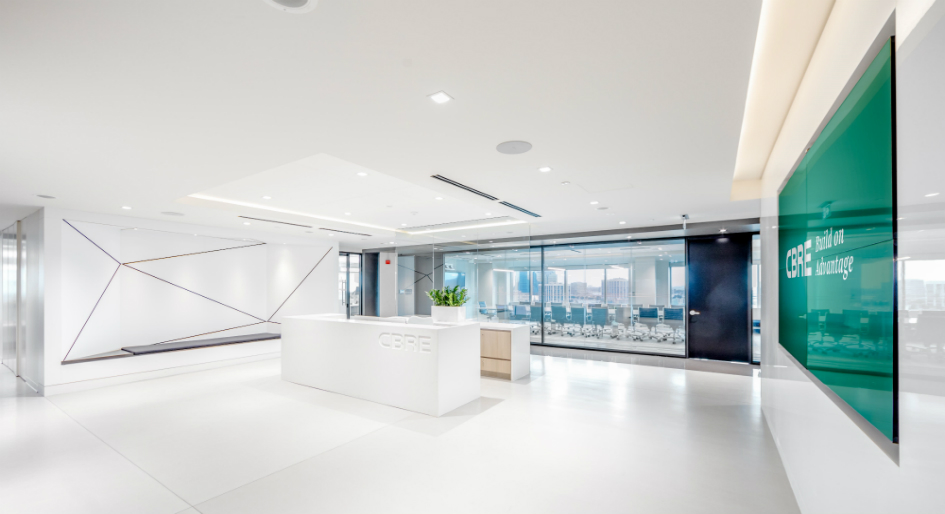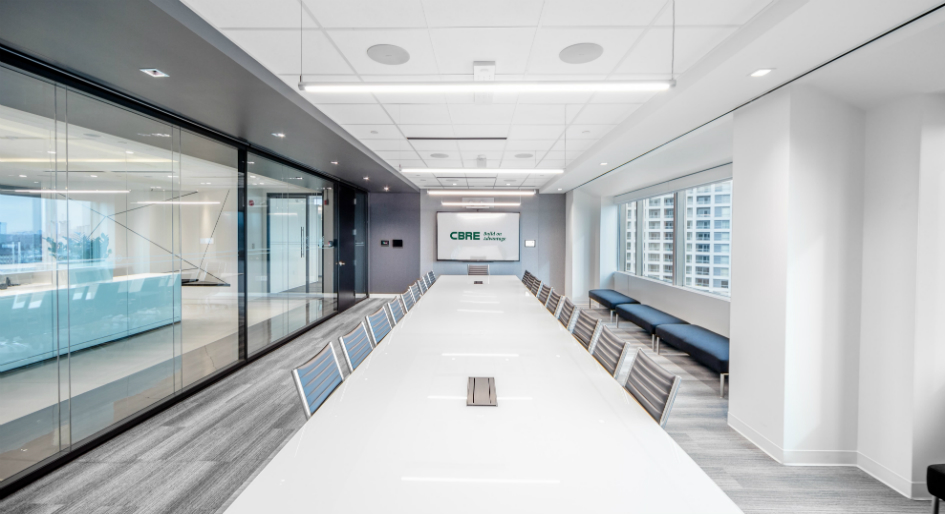As part of the world’s largest commercial real estate services firm, CBRE Limited (CBRE) guides clients through a market that is often complex and fast-paced. But its brand new Toronto North office reflects a simpler, more easygoing vibe. Clean white interiors and crisp blue accents bring an uncomplicated design and sense of calm to the new space—the fourth and final edition of the company’s 12-month-long GTA office transformation project.
The move up to the eighth floor of an adjacent building at 2005 Sheppard Avenue East also welcomes an abundance of natural light, a feature that helps comply with the WELL Building Standard, a performance-based system that takes a more human-centric approach to health and wellness in buildings. After piloting the program in its LA office, CBRE now has four out of the ten WELL-registered projects in Canada: one in Vancouver and three in the GTA, including the Toronto North office.
“We’re innovating with this new standard, seeing it as important in the evolution of corporate real estate,” says Managing Director of Workplace Strategy Lisa Fulford-Roy. “In going through the process, we now feel like we’re in a position to really advise our clients about WELL.”
Ensuring that all employees sit within 25 feet of natural sunlight and views was key to this process, along with installing a specialized circadian lighting system that automatically adjusts to the level of outside light. The system is designed to minimize the impact of electrical lighting on a worker’s natural circadian rhythm and sleep-wake cycles.
Investments like this increase engagement and attract and retain top talent.
“If our people are feeling better, they’re going to do better work and service our clients better,” adds Fulford-Roy. “From a value perspective, that really resonates with us in Canada and something we want to stand behind as leaders in the real estate service delivery capacity.”
WELL features
Following WELL guidelines that set out to measure, certify and monitor features related to light, air, water, nourishment, fitness, comfort and mind, the team implemented other elements related to wellness.
Good air quality is necessary to keep employees healthy and energized. In the Toronto North office, the HVAC system provides internal air quality in the top one per cent of offices globally, and sensors automatically pump in fresh air from outside when increased levels of carbon dioxide are detected.
“Employees and visitors consistently remark about the freshness of air,” says Adrian Lee, executive vice-president and Toronto North managing director. “There’s no yawning in meetings and people feel their energy is sustained throughout the day.”
Employees also sit within 30 metres of fresh filtered water. According to a study in the journal Frontiers in Human Neuroscience, thirsty individuals who drink water prior to performing a mental task have a faster reaction time than those who don’t drink water.
Noise cancellation diodes were also installed to create acoustic comfort and prevent background noise, a leading cause of stress and distraction for office workers.
The CBRE office is also one of the first to actually forbid workers from eating at desks. They’re encouraged to relax and connect with co-workers in the RISE café, in an informal setting that lures people away from their screens and keeps bacteria and odours from circulating the workspace. And to further promote physical activity and prevent back and shoulder pain, all employees now have sit-stand workstations.
“People are moving around and circulating more throughout the day, and there are greater levels of connections and casual collisions happening,” says Lee. “The sense of community has improved; there is less sedentary behaviour among leaders at all levels of the organization.”
WELL stakeholders
The WELL process is primarily tenant-driven rather than property manager-driven, but still requires specific engagement with a landlord and many stakeholders, adds Fulford-Roy. It’s different than LEED and more focused on human health and wellbeing. For instance, LEED helps workers gain access to daylight, whereas WELL considers how much daylight there is and how it’s dispersed. Still, some of these stakeholders are similar.
“Thirty per cent of the process involves impacting and integrating with base building systems, from air quality and air freshness to water quality,” adds Lee, adding that due to a three-year compliance and retesting period, a good relationship with the landlord and negotiations around HVAC targets is required, as well as a good relationship with stakeholders who impact the space.
“The most important stakeholder is our own employees,” adds Fulford-Roy. “Going through the WELL process enhanced our ability for change management, and helped us identify key benefits for our employees well in advance of occupancy. We were able to communicate back to them as part of the process, so day one of occupancy brought excitement and enthusiasm in the new space.”
WELL and existing buildings
All of the WELL-registered offices in the GTA are located in older assets. The Toronto North office is in a building about 30 years old. Even though age means more capital costs to improve existing space, the process isn’t improbable. In this case, all assets had undergone base building upgrades and tout various LEED and BOMA BEST certifications—a definite advantage in terms of capital costs required.
“If you can time a WELL project around capital costs being made in a similar time frame, I don’t think it’s impossible to achieve WELL in an older building,” adds Fulford-Roy. “But capital investment and negotiations with the landlord may be different.”
Canadian Workplace Transformation
Along with wellness, each GTA location was slightly tailored to the local population, but adhered to the unified, national office transformation strategy that involves three other core design philosophies: choice, connection and mobility. Overall this meant pursuing WELL certification, catering to a multigenerational workforce and various working styles, greater collaboration and getting employees working beyond their desks through advanced technology.
A clear vision, with such principles in mind, kept the team on track during the GTA office transformation project, which took less than a year to complete. Still, the strategy allowed for flexibility. A committee was set up to engage workers in planning adjacency or selecting furniture, artwork and finishing palettes to add a touch of personality to the space.
“We wanted to make sure that the employees at each location really felt they put their fingerprint on some of the decisions associated with the office, while keeping a consistent brand and image across Canada and making sure we maintained the values and priorities for a unified employee experience,” says Fulford-Roy.
CBRE had full supervision over the process, which gave them control over project management, construction, planning, executing and the physical relocation of employees, and helped ensure results were delivered on time. Not only does the program impact the health and wellness of employees, but offers clients real-life examples of what can be achieved.
“By achieving WELL in the physical environment, we’re actually impacting 100 per cent of our employees,” Lee notes. “That’s a powerful tool to attract and retain best talent and also increase the level of engagement and energy throughout the day. It’s something our employees will benefit from and, ultimately, our clients will benefit from their energy as well.”










